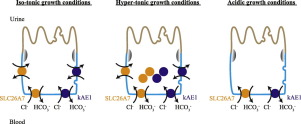当前位置:
X-MOL 学术
›
BBA Biomembr.
›
论文详情
Our official English website, www.x-mol.net, welcomes your
feedback! (Note: you will need to create a separate account there.)
SLC26A7 protein is a chloride/bicarbonate exchanger and its abundance is osmolarity- and pH-dependent in renal epithelial cells.
Biochimica et Biophysica Acta (BBA) - Biomembranes ( IF 2.8 ) Pub Date : 2020-02-28 , DOI: 10.1016/j.bbamem.2020.183238 A K M Shahid Ullah 1 , A Carly Rumley 1 , Valentina Peleh 2 , Daphne Fernandes 1 , Ensaf Y Almomani 3 , Mattia Berrini 1 , Rawad Lashhab 1 , Nicolas Touret 4 , R Todd Alexander 1 , Johannes M Herrmann 2 , Emmanuelle Cordat 1
Biochimica et Biophysica Acta (BBA) - Biomembranes ( IF 2.8 ) Pub Date : 2020-02-28 , DOI: 10.1016/j.bbamem.2020.183238 A K M Shahid Ullah 1 , A Carly Rumley 1 , Valentina Peleh 2 , Daphne Fernandes 1 , Ensaf Y Almomani 3 , Mattia Berrini 1 , Rawad Lashhab 1 , Nicolas Touret 4 , R Todd Alexander 1 , Johannes M Herrmann 2 , Emmanuelle Cordat 1
Affiliation

|
Acid-secreting intercalated cells of the collecting duct express the chloride/bicarbonate kidney anion exchanger 1 (kAE1) as well as SLC26A7, two proteins that colocalize in the basolateral membrane. The latter protein has been reported to function either as a chloride/bicarbonate exchanger or a chloride channel. Both kAE1 and SLC26A7 are detected in the renal medulla, an environment hyper-osmotic to plasma. Individuals with mutations in the SLC4A1 gene encoding kAE1 and mice lacking SLC26A7 develop distal renal tubular acidosis (dRTA). Here, we aimed to (i) confirm that SLC26A7 can function as chloride/bicarbonate exchanger in Madin-Darby canine kidney (MDCK) cells, and (ii) examine the behavior of SLC26A7 relative to kAE1 wild type or carrying the dRTA mutation R901X in iso- or hyper-osmotic conditions mimicking the renal medulla. Although we found that SLC26A7 abundance increases in hyper-osmotic growth medium, it is reduced in low pH growth conditions mimicking acidosis when expressed at high levels in MDCK cells. In these cells, SLC26A7 exchange activity was independent from extracellular osmolarity. When SLC26A7 protein was co-expressed with kAE1 WT or the R901X dRTA mutant, the cellular chloride/bicarbonate exchange rate was not additive compared to when proteins are expressed individually, possibly reflecting a decreased overall protein expression. Furthermore, the cellular chloride/bicarbonate exchange rate was osmolarity-independent. Together, these results show that (i) in MDCK cells, SLC26A7 is a chloride/bicarbonate exchanger whose abundance is up-regulated by high osmolarity growth medium and (ii) acidic extracellular pH decreases the abundance of SLC26A7 protein.
中文翻译:

SLC26A7蛋白是一种氯化物/碳酸氢盐交换剂,在肾脏上皮细胞中,其丰度与渗透压和pH有关。
收集管中分泌酸的插层细胞表达氯离子/碳酸氢根肾脏阴离子交换剂1(kAE1)以及SLC26A7,这两种蛋白共定位在基底外侧膜中。据报道,后者蛋白质起着氯化物/碳酸氢盐交换剂或氯化物通道的作用。kAE1和SLC26A7都在肾脏髓质中检测到,肾脏是血浆过度渗透的环境。具有编码kAE1的SLC4A1基因突变的个体和缺乏SLC26A7的小鼠会发生远端肾小管性酸中毒(dRTA)。在此,我们旨在(i)确认SLC26A7可以在Madin-Darby犬肾(MDCK)细胞中充当氯化物/碳酸氢盐交换剂,并且(ii)检查SLC26A7相对于kAE1野生型或携带dRTA突变R901X的行为。模拟肾髓质的等渗或高渗条件。尽管我们发现SLC26A7在高渗透性生长培养基中的丰度增加,但在低pH值生长条件下(模拟酸中毒)在MDCK细胞中以高水平表达时,其含量会降低。在这些细胞中,SLC26A7交换活性独立于细胞渗透压。当SLC26A7蛋白与kAE1 WT或R901X dRTA突变体共表达时,与单独表达蛋白时相比,细胞氯化物/碳酸氢盐交换速率不加和,可能反映了总体蛋白表达降低。此外,细胞中氯离子/碳酸氢盐的交换速率与渗透压无关。这些结果加在一起表明(i)在MDCK细胞中,
更新日期:2020-03-19
中文翻译:

SLC26A7蛋白是一种氯化物/碳酸氢盐交换剂,在肾脏上皮细胞中,其丰度与渗透压和pH有关。
收集管中分泌酸的插层细胞表达氯离子/碳酸氢根肾脏阴离子交换剂1(kAE1)以及SLC26A7,这两种蛋白共定位在基底外侧膜中。据报道,后者蛋白质起着氯化物/碳酸氢盐交换剂或氯化物通道的作用。kAE1和SLC26A7都在肾脏髓质中检测到,肾脏是血浆过度渗透的环境。具有编码kAE1的SLC4A1基因突变的个体和缺乏SLC26A7的小鼠会发生远端肾小管性酸中毒(dRTA)。在此,我们旨在(i)确认SLC26A7可以在Madin-Darby犬肾(MDCK)细胞中充当氯化物/碳酸氢盐交换剂,并且(ii)检查SLC26A7相对于kAE1野生型或携带dRTA突变R901X的行为。模拟肾髓质的等渗或高渗条件。尽管我们发现SLC26A7在高渗透性生长培养基中的丰度增加,但在低pH值生长条件下(模拟酸中毒)在MDCK细胞中以高水平表达时,其含量会降低。在这些细胞中,SLC26A7交换活性独立于细胞渗透压。当SLC26A7蛋白与kAE1 WT或R901X dRTA突变体共表达时,与单独表达蛋白时相比,细胞氯化物/碳酸氢盐交换速率不加和,可能反映了总体蛋白表达降低。此外,细胞中氯离子/碳酸氢盐的交换速率与渗透压无关。这些结果加在一起表明(i)在MDCK细胞中,











































 京公网安备 11010802027423号
京公网安备 11010802027423号